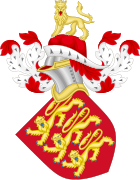| Act of Parliament | |
 | |
| Citation | 13 Edw. 1. c. 1 |
|---|---|
Status: Current legislation | |
| Text of statute as originally enacted | |
| Revised text of statute as amended | |
De donis conditionalibus or the Estates Tail Act 1285 is a chapter of the English Statutes of Westminster (1285).[1] It originated the law of entail – forbidding a landholder to sell his land except to his heirs.
YouTube Encyclopedic
-
1/1Views:622
-
University of Iowa College of Law Commencement - May 15, 2015
Transcription
Background
A form of entail has been known before the Norman feudal law had been domesticated in England. The common form was a grant "to the feoffee and the heirs of his body", by which limitation it was sought to prevent alienation from the lineage of the first purchaser. These grants were also known as feuda conditionata, because if the donee had no heirs of his body the estate reverted to the donor. This right of reversion was evaded by the interpretation that such a gift was a conditional fee, which enabled the donee, if he had an heir of the body born alive, to alienate the land, and consequently disinherit the issue and defeat the right of the donor. To remedy this the statute De donis conditionalibus was passed.
The statute
In 1285 the statute De donis conditionalibus enacted that in grants to a man and his heirs, the will of the donor as expressed in the grant should be followed. The donee should have no power to dispose of the land in any other way. After the donee's death, the land would be inherited by his heirs – or if he had no heirs, then by the donor or the donor's heirs.
Since the passing of the statute, an estate given to a man and the heirs of his body has been known as an estate tail, or an estate in fee tail (feudum talliatum). The word tail is derived from the French tailler, to cut, the inheritance being by the statute cut down and confined to the heirs of the body.
Criticism
It is claimed that the operation of the statute produced innumerable evils: "children, it is said, grew disobedient when they knew they could not be set aside; farmers were deprived of their leases; creditors were defrauded of their debts; innumerable latent entails were produced to deprive purchasers of the land they had fairly bought; treasons also were encouraged, as estates tail were not liable to forfeiture longer than for the tenant's life".[2][3]
On the other hand, by limiting inheritance to the eldest son, the other issue were forced to seek employment elsewhere, thus, it has been argued, preventing the growth of a landed caste. The professions of the church, the army and the law were constantly recruited from the younger sons of landed families, preventing the gap between nobility and the rest.[4]
Aftermath
The power of alienation was reintroduced by the judges in Taltarum's Case (Year Book, 12 Edward IV., 1472) by means of a fictitious suit or recovery which had originally been devised by the regular clergy for evading the statutes of Mortmain.[2]
This was abolished by the Fines and Recoveries Act 1833, which provided an alternative means of barring entails.[5]
See also
References
- ^ Text of the Statute of Westminster the Second (De Donis Conditionalibus) 1285 (c. 1) as in force today (including any amendments) within the United Kingdom, from legislation.gov.uk.
- ^ a b One or more of the preceding sentences incorporates text from a publication now in the public domain: Chisholm, Hugh, ed. (1911). "De Donis Conditionalibus". Encyclopædia Britannica. Vol. 7 (11th ed.). Cambridge University Press. p. 920.
- ^ Williams, Real Property
- ^ Warner and Marten, Groundwork of British History
- ^ "Fines and Recoveries Act 1833". The National Archives (United Kingdom). Retrieved 28 June 2022.
